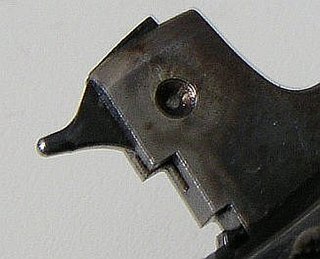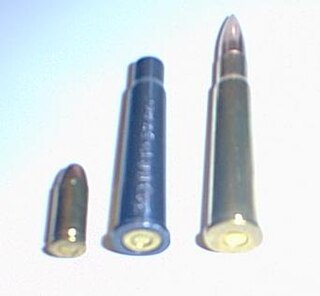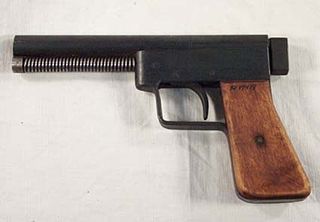

A flare gun, also known as a Very pistol or signal pistol, is a large-bore handgun that discharges flares, blanks and smoke. The flare gun is typically used to produce a distress signal.


A flare gun, also known as a Very pistol or signal pistol, is a large-bore handgun that discharges flares, blanks and smoke. The flare gun is typically used to produce a distress signal.
The most common type of flare gun is a Very (sometimes spelled Verey), [1] which was named after Edward Wilson Very (1847–1910), an American naval officer who developed and popularized a single-shot breech-loading snub-nosed pistol that fired flares (Very lights). [2] They have a single action trigger mechanism, hammer action, and a center fire pin. [3] Modern varieties are frequently made out of durable plastic of a bright colour that makes them more conspicuous and easier to retrieve in an emergency and assists in distinguishing them from conventional firearms.

The Very pistol, typical of the type used in the Second World War, are of one inch[ inconsistent ] bore (26.5mm), now known as "Calibre 4" for signal pistols. [4] These are still available and more recent longer-barrel models can also fire parachute flares. [5] Many newer models fire smaller 12-gauge flares.[ citation needed ] In countries where possession of firearms is strictly controlled, such as the United Kingdom, the use of Very pistols as emergency equipment on boats is less common than, for example, the United States. In such locations, distress flares are more commonly fired from single-shot tube devices which are then disposed of after use. These devices are fired by twisting or striking a pad on one end, but the contents are otherwise similar to a round from a flare gun, although the flares themselves are much larger and can burn brighter for longer.[ citation needed ] In the Russian Federation, which also has strict controls on firearms, a special tube-shaped flare launching device called a "Hunter's Signal" (Сигнал Охотника) is available. This is reusable but is deliberately designed in a way to avoid resemblance to a gun.
Flare guns may be used whenever someone needs to send a distress signal. The flares must be shot directly above, making the signal visible for a longer period of time and revealing the position of whoever is in need of assistance. There are four distinct flare calibers: 12-gauge (18.53mm), 25mm, 26.5mm, and 37mm –the first three being the most popular for boaters.

Flare guns may be used for the destruction of flammable material, or in an anti-personnel role. [6] [7] [8]
In World War II, Germany manufactured grenades designed to be fired from adapted flare guns known as the Sturmpistole in its final form. Fragmentation and anti-tank grenades were produced, but the latter would likely have been of limited use against late-war armoured vehicles. [9]
The Soviets developed the Baranov pocket mortar during 1943, which fired a 175g round with an 8g explosive charge out to a range of 200-350m (it was also proposed to increase this to 600-700m). [10] A later development was the PSA/PSA-1/ASP, a copy of the US issue M8 flare pistol. This fired an experimental grenade which was 40% more powerful than that used with the Kampfpistole. [ citation needed ]
Conversion kits are available intended to convert flare guns to accept conventional ammunition by use of barrel inserts. There are also 12 gauge inserts intended to allow use of rifle or pistol ammunition in conventional 12 gauge shotguns. Use of any of these devices in the Orion plastic 12 gauge flare gun is not recommended by the manufacturer and ATF tests have demonstrated that sometimes a single use results in a catastrophic failure. In the United States, if these conversion kits are used in a metal flare gun, the converted gun is considered to be a firearm by the ATF. If a rifled barrel insert is used, the converted firearm is classified as a pistol; if a smoothbore barrel insert is used, the converted firearm is classified as an AOW subject to the additional requirements of the NFA. [11] Flare cartridges are low pressure compared to conventional ammunition and even metal flare guns are not designed or intended to be used with conventional ammunition. Conversion of a flare gun to fire conventional ammunition may also be restricted by local improvised firearm laws.

A carbine is a long gun that has a barrel shortened from its original length. Most modern carbines are rifles that are compact versions of a longer rifle or are rifles chambered for less powerful cartridges.

A firearm is any type of gun that uses an explosive charge and is designed to be readily carried and used by an individual. The term is legally defined further in different countries.

The percussion cap, percussion primer, or caplock, introduced in the early 1820s, is a type of single-use percussion ignition device for muzzle loader firearm locks enabling them to fire reliably in any weather condition. Its invention gave rise to the caplock mechanism or percussion lock system which used percussion caps struck by the hammer to set off the gunpowder charge in rifles and cap and ball firearms. Any firearm using a caplock mechanism is a percussion gun. Any long gun with a cap-lock mechanism and rifled barrel is a percussion rifle. Cap and ball describes cap-lock firearms discharging a single bore-diameter spherical bullet with each shot.

A grenade launcher is a weapon that fires a specially designed, large-caliber projectile, often with an explosive, smoke, or gas warhead. Today, the term generally refers to a class of dedicated firearms firing unitary grenade cartridges. The most common type are man-portable, shoulder-fired weapons issued to individuals, although larger crew-served launchers are issued at higher levels of organization by military forces.

A blank is a firearm cartridge that, when fired, does not shoot a projectile like a bullet or pellet, but generates a muzzle flash and an explosive sound like a normal gunshot would. Firearms may need to be modified to allow a blank to cycle the action, and the shooter experiences less recoil with a blank than with a live round. Blanks are often used in prop guns for shooting simulations that have no need for ballistic results, but still demand light and sound effects, such as in historical reenactments, special effects for theatre, movie and television productions, combat training, for signaling, and cowboy mounted shooting. Specialised blank cartridges are also used for their propellant force in fields as varied as construction, shooting sports, and fishing and general recreation.

A firing pin or striker is a part of the firing mechanism of a firearm that impacts the primer in the base of a cartridge and causes it to fire. In firearms terminology, a striker is a particular type of firing pin where a compressed spring acts directly on the firing pin to provide the impact force rather than it being struck by a hammer.

The Gyrojet is a family of unique firearms developed in the 1960s named for the method of gyroscopically stabilizing its projectiles. Rather than inert bullets, Gyrojets fire small rockets called Microjets which have little recoil and do not require a heavy barrel or chamber to resist the pressure of the combustion gases. Velocity on leaving the tube was very low, but increased to around 1,250 feet per second (380 m/s) at 30 feet (9.1 m). The result is a very lightweight and transportable weapon.

The .410 bore (10.4 mm) is one of the smallest caliber of shotgun shell commonly available. A .410 bore shotgun loaded with shot shells is well suited for small game hunting and pest control. The .410 started off in the United Kingdom as a garden gun along with the .360 and the No. 3 bore (9 mm) rimfire, No. 2 bore (7 mm) rimfire, and No. 1 bore (6 mm) rimfire. .410 shells have similar base dimensions to the .45 Colt cartridge, allowing many single-shot firearms, as well as derringers and revolvers chambered in that caliber, to fire .410 shot shells without any modifications.
A powerhead is a specialized firearm used underwater that is fired when in direct contact with the target. Powerheads are often used for spear fishing and against sharks or alligators for sport, defense, or to kill nuisance animals. The term powerhead refers to the firearm-like part of the device; when attached to a shaft to form a spear, it may be referred to as a bang stick or shark stick. The spear in question may be handheld or launchable from a spear gun.

A caliber conversion sleeve or adapter sleeve is a device which can be used to non-permanently alter a firearm to allow it to fire a different cartridge than the one it was originally designed to fire. The different cartridge must be smaller in some dimensions than the original design cartridge, and since smaller cartridges are usually cheaper, the device allows less expensive fire practice.
37 mm flare or "1.5 inch" caliber is the specification for a common launching system for non-lethal and less-lethal ammunition. Such launchers are also often known as "gas guns" due to their original use by police for launching tear gas projectiles. 37 mm systems are typically smoothbore as rifling is unnecessary or even detrimental to the performance of the usual projectiles.

Break action is a type of firearm action in which the barrel(s) are hinged much like a door and rotate perpendicularly to the bore axis to expose the breech and allow loading and unloading of cartridges. A separate operation may be required for the cocking of a hammer to fire the new round. There are many types of break-action firearms; break actions are universal in double-barreled shotguns, double-barreled rifles, combination guns, and are commonly found in single shot pistols, rifles, shotguns, including flare guns, grenade launchers, air guns, and some older revolver designs. They are also known as hinge-action, break-open, break-barrel, break-top, or, on old revolvers, top-break actions.

Improvised firearms are firearms manufactured other than by a firearms manufacturer or a gunsmith, and are typically constructed by adapting existing materials to the purpose. They range in quality from crude weapons that are as much a danger to the user as the target to high-quality arms produced by cottage industries using salvaged and repurposed materials.

An antique firearm is a term used to describe a firearm that was designed and manufactured prior to the beginning of the 20th century. Although the exact definition of what constitutes an "antique firearm" varies between countries, the advent of smokeless powder or the start of the Boer War are often used as cut-off dates. Antique firearms are usually collected because of their historical interest and/or their monetary value.
The following are terms related to firearms and ammunition topics.

Title II weapons, or NFA firearms, are designations of certain weapons under the United States National Firearms Act (NFA).

The TP-82 is an out-of-service triple-barreled Soviet combination gun carried by cosmonauts on space missions. It was intended as a survival aid to be used after landings and before recovery in the Siberian wilderness.
The Manville gun was a stockless, semi-automatic, revolver type gun, introduced in 1935 by Charles J. Manville. The Manville Gun was a large weapon, with a heavy cylinder being rotated for each shot by a clockwork-type spring. The spring was wound manually during the reloading.
Chiappa Firearms, Armi Sport di Chiappa, is an Italian firearms manufacturing company based in Brescia. It was founded in 1958 by Ezechiele Chiappa as Armi Sport. Total unit production is around 60,000 per year. Its U.S. headquarters are in Dayton, Ohio.

The Leuchtpistole 34 or flare gun in English was introduced into German service before World War II and served throughout World War II.
Another historically famous flare, still in use, is the Very light, invented by a U.S. naval officer, Edward W. Very (1874–1910). It is white or colored and is fired from a special pistol.